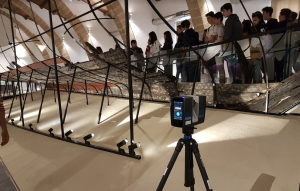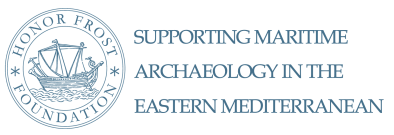Cannabis And The Colour Purple
Dive & Dig Blog by Lauren Tidbury

In episode four of Dive & Dig we wanted to explore what happens to a ship when it sinks and what conservation and analysis techniques can be used to preserve and better understand a site. As you can imagine that is a great deal of content to fit into one episode, thankfully we had some brilliant experts to help us!
We first spoke to Stella Demesticha from the University of Cyprus who has been working on the Mazotos shipwreck. Stella discusses the factors that impact on the site formation process, the wrecking process itself, the nature of the seabed and how this all affects whether a ship remains relatively intact or whether it becomes dispersed and scattered. The Mazotos wreck lies on a flat sandy seabed which has ensured it’s good preservation.
This led on to site stabilization. How do we preserve fragile organics that were buried and thankfully remain intact on the seabed? As archaeologists excavate we disturb the wreck and thus conservation is critical. Our fellow podcast developer Cathy Giangrande is a leading expert in conservation and was able to describe the various chemical and physical processes that a ship undergoes in the process of wrecking. Understanding these processes can help inform on the best approaches to their recovery, as well as first aid and longer term conservation strategies. Obviously with so many different types of material there are many different conservation techniques required. We therefore focussed on timber and the use of Polyethylene Glycol (PEG). This petroleum based substance supports the cell structure of wood, and has been used by archaeologists for over fifty years. It was used by Honor Frost on the Marsala Punic Ship. This 3rd Century BC ship, found off the coast of Sicily, was excavated in the early 1970’s and treated with PEG. Honor however, being ahead of her time, also realised the importance of preserving and documenting the timbers in other ways, so she created plaster casts of the timbers. The Foundation has recently supported a project to digitally record the timbers, and this was the point of my debut on the podcast! I briefly contributed to this episode to talk about how photogrammetry and laser scanning of the hull remains has allowed the team to create a digital archive of the timbers, not only preserving them by record but also helping to inform future conservation strategies. Find out more about the project and the team involved in this in the links below.
Staying on the subject of the Marsala Punic Ship and digital documentation, we spoke to Grant Cox who has been using CGI to help us create a virtual dive. As the ship was excavated fifty years ago, photogrammetry had yet to be applied underwater. Instead we have meticulous 2D pencil drawings, site plans, photos and detailed records that Honor Frost generated. Grant and I used these to recreate the site and the environment as it would have looked during the excavation. A virtual exhibition including the virtual dive will be launched soon to celebrate the fifty year anniversary, so keep an eye on our website!
Another fascinating story from the Marsala Punic Ship was the incredible preservation of organic material. We had to tell the story of the cannabis discovery! Honor was intrigued by yellow plant-like stems she was finding, she even found a whole basket of them preserved. Honor sent them to the Jodrell labs at the Royal Botanic Gardens, Kew , UK and the results came back as being Cannabis Sativa. It’s possible these stems were chewed or made into an infusion of tea for the crew!
We then turned our attention back to Timmy Gambin and the Phoenician shipwreck he is excavating off the coast of Gozo, Malta. We wanted to find out more about the different analytical techniques that his team are using to better understand the site and it’s wider context.
Timmy began by telling us about the ceramic finds and how we can use thin sections to discover where the clay came from and potentially where the ceramics were made. We can also look at what they were carrying. Timmy explains that amphorae lined with pitch indicate that they may have been carrying wine, as the lining prevented the wine from taking on a bad taste from the ceramic container. But this is not all we can learn, Timmy introduced us to Cynthianne Spiteri who has been undertaking lipid analysis on the amphorae. Cynthianne explained that lipids are a group of compounds, mostly oils and fats which are absorbed by ceramics during their use. They are strong molecules which survive well and can be extracted for analysis to tell us what the amphorae were carrying and potentially this can lead us to understand the origin of the cargo and the wide trade network of the ship that transported the cargo.
Lucy then went on to interview the forensic scientist Roland Wesling about isotopic analysis, he explained how isotopes are modifications of atoms and that they vary depending on where you are in the world. This fascinating technique can be used to look at where people lived and travelled in the past, and can even tell us about their diet!
Finally, we couldn’t talk about the Phoenicians without mentioning murex shells. Prof. David Abulafia told us about how these molluscs were used by the Phoencicians to produce a rich dye, in particular the purple dye associated with royalty. Phoenicians were renowned for purple dye and Timmy told us about how they are currently analysing some shells from his wreck site, so watch this space, perhaps this ship was also carrying the shells that make the famous purple dye!
All these analytical techniques can help us to piece together the story of the shipwreck, Timmy also discussed a very recent discovery. As they were sieving the content of one of the amphorae they found a small bone belonging to either a lamb or baby goat. DNA analysis is planned to see if they can identify where this animal came from and any chemical traces which could indicate if/how it was cured. As Timmy said, a seemingly small find can open up so many possibilities and so many more research questions!
We learnt in this episode how important conservation is and how we need to understand site formation processes in order to plan excavation and conservation strategies. We looked back at the work on the Marsala Punic Ship, a great example of remarkable preservation, and demonstrating how the analysis of finds can lead to some unexpected discoveries. The recent analysis techniques being used on the Phoenician shipwreck is really exciting, helping the team to better understand where the ship may have been, and placing it in its wider context to understand the Phoenician world more fully.
To listen click here https://audioboom.com/dashboard/5052122
LINKS
To find out more about the work being undertaken on the Mazotos Shipwreck by Stella Demesticha and her team at the University of Cyprus click here.
To find out more about the digital documentation project on the Marsala Punic Ship click here.
To explore how CGI is being used to recreate archaeological sites visit Grant Cox’s website here
To continue explore the Phoenician Shipwreck and the analysis work being undertaken by Timmy Gambin and his team check out the project website here
Find out more about Roland Wesling and his work on isotope analysis here
Find out more about the fascinating murex shells and the Phoenician World in Prof. David Abulafia’s books.
